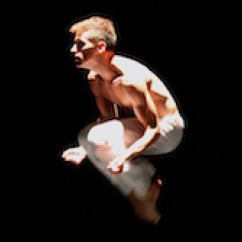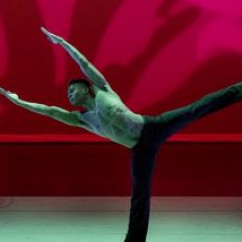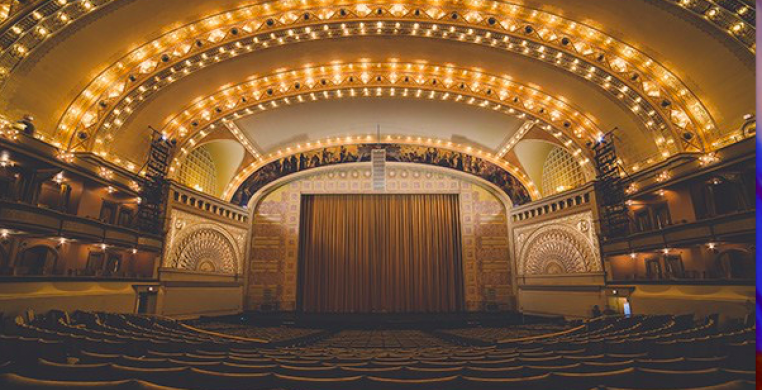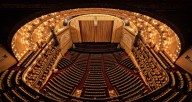The star of the show was the historic Auditorium Theatre, the golden-hued palace itself, celebrating the 50th anniversary of its restoration and re-opening, but a star-studded program treated its audience to a glittering array of virtuoso dance that did its stage proud.
The theater, designed by Sullivan and Adler and completed in 1889, was dramatically front and center throughout the night in stunning life-size drawings of the building and its interior spaces projected across the entire span of the stage, establishing both a frame for conveying the history of the Auditorium Theatre, and a unifying theme as scenic backdrops for the evening’s 13 separate acts. Auditorium Theatre Re-Opening, 1967
Auditorium Theatre Re-Opening, 1967
As the curtains opened, a projection of the hand-drawn Auditorium proscenium and stage echoed its real-life model, a theater-within-a-theater. Rows of empty seats on stage, their backs to us, faced the projection.
A clever prologue saw an on-stage “audience” of chic theater patrons strolling in to take their seats. A video montage, projected onto the stage-within-a-stage, recreated all the excitement of opening night in 1967, with excerpts from New York City Ballet’s performance of George Balanchine’s “A Midsummer Night’s Dream,” starring Edward Villella and Suzanne Farrell.
At its close, the on-stage audience filed off, all but one. In a dramatic reveal, an elegant older gentleman turned slowly toward us and smiled with the unmistakable warmth of Edward Villella in person, here as honorary co-chair of the 50th gala celebration to welcome us, and to reminisce about what it was like on that dazzling historic night fifty years ago. “I had danced in the greatest theaters all over the world,” he said. “I’d danced in Paris, London, China, Russia, New York; but I’d never danced in a theatre like this!” (Co-chair Suzanne Farrell, spoke in absentia via video.)
This theatrical construct created an imaginative link between 1967 and the present, and avoided what could have played out as an extended variety show of disconnected solos, duets, and one ensemble piece. Instead, it knit together an integrated presentation, carefully-curated by Auditorium Theatre CEO Tania Castroverde Moskalenko. The creative team that realized this visual spectacle combined Frédéric O. Boulay’s projection designs with animation by Anastasia Victorova. Historic video footage, subtitles, and voice-over narration interspersed live performances with historic details that put each dance offering, and the companies performing them, in historic context.
The Gala was a ballet lover’s feast, showcasing all the flair, technical bravura and classicism of some of the today’s greatest classical ballet practitioners. Seven pas de deux, ranging from Petipa’s fiery 1869 “Don Quixote,” performed by San Francisco Ballet’s Maria Kochetkova and Daniil Simkin representing American Ballet Theatre and Berlin State Ballet, to Yuri Possokhov’s impassioned contemporary “Bells” (2011), brilliantly danced by Joffrey Ballet’s resident sweethearts, Victoria Jaiani and Temur Suluashvili. San Francisco Ballet’s Koto Ishihara and Washington Ballet’s Brooklyn Mack recreated Agrippina Vaganova’s historic “Diana and Acteon” pas de deux from “Esmeralda” (1935), a classical wonder with Mack’s mind-boggling renversé/barrel turn/fouetté (how’d he DO that) phenomenon. Victoria Jiani and Temur Suluashvili in "Bells"
Victoria Jiani and Temur Suluashvili in "Bells"
In between we dined on a sumptuous Balanchine retrospective with New York City Ballet’s Megan Fairchild and Daniel Ulbricht’s playful interpretation of “Tarantella” (1964), Michael Cook and Natalia Magnicaballi of the Suzanne Farrell Ballet in the poetic “Meditation” (1963), and the “Chaconne” pas de deux (1976) performed with precision and flare by Ballet West’s Emily Adams and Adrian Fry.  Megan Fairchild and Daniel Ulbrecht in "Tarantella"
Megan Fairchild and Daniel Ulbrecht in "Tarantella"
In a nod to Pavlova’s 1889 Auditorium Theatre opening night performance, Liudmila Konovalova of the Vienna State Ballet gave us a poignant rendition of “The Swan,” a harbinger of modernity choreographed by Michael Fokine in 1905. And Youth American Grand Prix winner Madison Penney’s precocious solo performance of the variation from Perrot and Petipa’s “Esmeralda” (1886) reminded us that nineteenth-century ballet capitalized on pure and unabashed technical showmanship, which this young lady has in abundance.
As brilliant and entertaining as all those wonderful briseés voleés, double cabrioles, and fouetté turns, three solo novelties added welcome spice to the night. Daniil Simkin proved remarkably versatile, doubling as danseur noble in “Don Q” and as Jacques Brell’s affable clown in Ben van Cauwenbergh’s “Les Bourgeous,” and Ian Spring astounded in David Parsons’ “Caught” (1982), in which strobe flashes caught him mid air for a choreographic version of trompe l’oeil. A Third solo, Robert Battle’s “Takademe” (1999), performed with humor and uncanny musicality by Alvin Ailey’s rhythmic wonderkind, Solomon Dumas, perfectly mirrored the Indian Kathak syllables  Ian Spring in "Caught"
of Sheila Chandra’s music.
Ian Spring in "Caught"
of Sheila Chandra’s music. Alvin Ailey's Solomon Dumas
Alvin Ailey's Solomon Dumas
Moses Pendleton”s “Millennium Skiva” (2012) put MOMIX’s Todd Burnsed and Nicole Loizides in moon boots attached to skis for some novel, silver-clad anti-gravity tricks. But the Act One closer, Hubbard Street’s excerpt from Crystal Pice’s “Solo Echo” (2012), the only ensemble piece of the evening, resonates beyond the bravura and flash, beyond the tricks and novelties and entertainments of the night, wonderful as they were, to a deeper place that doesn’t go away after you leave the theatre, get in your car, and drive home. It stays with you in the haunting eternity of snow falling always, and open mouths in silent scream, and hands reaching hands out and out but to what; in the domino of falling bodies and interlocking ams and the loneliness of humanity in the face of forever.  Hubbard Street in "Solo Echo"
Hubbard Street in "Solo Echo"


